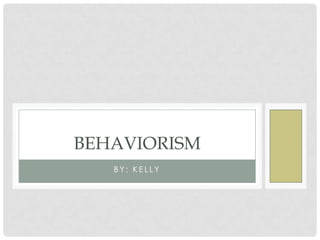Behaviorism
- 1. B Y : K E L L Y BEHAVIORISM
- 2. WHAT IS BEHAVIORISM? ? The prediction and control of human behavior in which introspection and/or independent thinking play no essential part of its teaching methods. ? It teaches people to behave through the system of positive and negative awards ? Positive applies a stimulus (reward) toward the desired behavior. Negative withholds any stimulus for the unwanted behavior.
- 3. POSITIVE AND NEGATIVE REINGFORCEMENT ? It teaches students to behave through the system of positive and negative awards ? Positive applies a stimulus (reward) toward the desired behavior. Negative withholds any stimulus for the unwanted behavior.
- 4. POSITIVE AND NEGATIVE PUNISHMENT ? Positive punishment is when unfavorable events or outcomes are given in order to weaken the response that follows ? Negative punishment is characterized by when an favorable event or outcome is removed after a undesired behavior occurs
- 5. IVAN PAVLOV ? Experimented with classic conditioning techniques which refers to the natural reflex that occurs in response to stimulus ? He proved this theory with an experiment using dogs; he used conditioning to teach dogs to salivate when he rang a bell. He provided food as a stimulus and a bell to trigger the reflex (salivation), eventually the dogs associated the bell with food and began to salivate when the bell rang.
- 6. B.F. SKINNER ? Operant conditioning describes learning that is controlled and results in shaping behavior through reinforcement of stimulus- response patterns ? He believed that people shape their behavior based on the rewards or positive reinforcement they receive. He found reinforcement to be a powerful motivator.
- 7. ALBERT BANDURA ? Social Cognitive Theory focuses on those motivational factors and self-regulatory mechanisms that contribute to a persons behavior. Rather than just environmental mechanisms ? He analyzed a persons personality through the interaction of three things: the environment, the behavior, and the personĄŊs psychological processes
- 8. CLASSROOM IMPLICATIONS WITHOUT TECHNOLOGY ? A teacher passing out candy to a child who is calm and well behaved. The students will eventually realize that the model students behavior is the reason for the reward and will voluntarily act in a call and well behaved manner in hopes of the reward ? Also rewarding students for good grades can motivate the other students to do better on their work
- 9. CLASSROOM IMPLICATIONS WITH TECHNOLOGY ? The computer software will provide positive feedback for students who get the correct answer either through a verbal response, picture, or video
- 10. THOUGHTS ? I am a strong believer in Behaviorism. I believe students will base their behavior on the positive and negative comments or actions a teacher gives them, especially with rewards. At an early age students are more susceptible to conform to what other students are doing. If they see one child behaving and being rewarded for it they will conform and become well behaved for the reward.
- 11. WORK CITED ? Pavlov photo: http://www.flickr.com/photos/psychpics/3429017524/">Psychology Pictures</a> via <a href="http://photopin.com">photopin</a> <a href="http://creativecommons.org/licenses/by-nc-nd/2.0/">cc</a> ? Bandura photo: https://www.flickr.com/photos/50428287@N05/6118948672/in/photolist- 4tBmvz-6v4qfq-ajHdg3-ajDZjr-ajExbg-ehzo2s-4yF8SU-8r9EJw-5eG3jx-2QqQhu-8ZGNDR- 8ZGRRr-8ZGTtv-8ZGR1F-8ZKTPQ-8ZKRBf-8ZKYTj-8ZGMzZ-8ZGPGv-8ZKStE-dGNMcw-dGHnUx ? Skinner photo: https://www.flickr.com/photos/50428287@N05/6118948428/in/photolist- bBMJN1-afgZyF-7Vyweq-ah5KNA-8hh6wC-8hh6uS-8hh6sj-8hdQXF-rZzQm-gdoyn-9Lg62Z- 9Lg5ng-9LiRMu-9LiSos-9Lg5ga-9Lg51B-9Lg5yr-dVBske-mrFnAx-d5rmo7-m9MW9r-eToktt- jCajSz-jCeLzS-ajH4gb-hUR4x6-9atP1Z-fDXrpt-ajHjV7-9atP3n-ajGM29-ajHdbQ-b3Pbtn- aynZQW-ehvarn-ehAXDj-9ZD8Yo-fGWnVE-fEf8Tq-fEf363-8GHMfq-8d8YZu-6ZG2zn-EvZs- Ew1X-9LZhsD-4yFMRe-6mtT53-e5ZT2a-52rjJZ ? Shelly , G. B., Gunter , G. A., & Gunter , R. E. (2012). Teachers discovering computer integrating technology in a connected world . (7th ed., pp. 258-261). Boston : Course Technology, Cengage Learning ? Behaviorism . (n.d.). Retrieved from http://www.learning-theories.com/behaviorism.html











